Understanding Lake Worth Weather for Kiteboarding Success
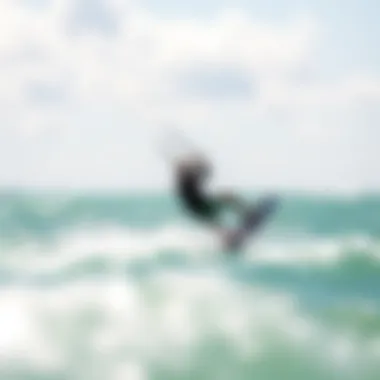
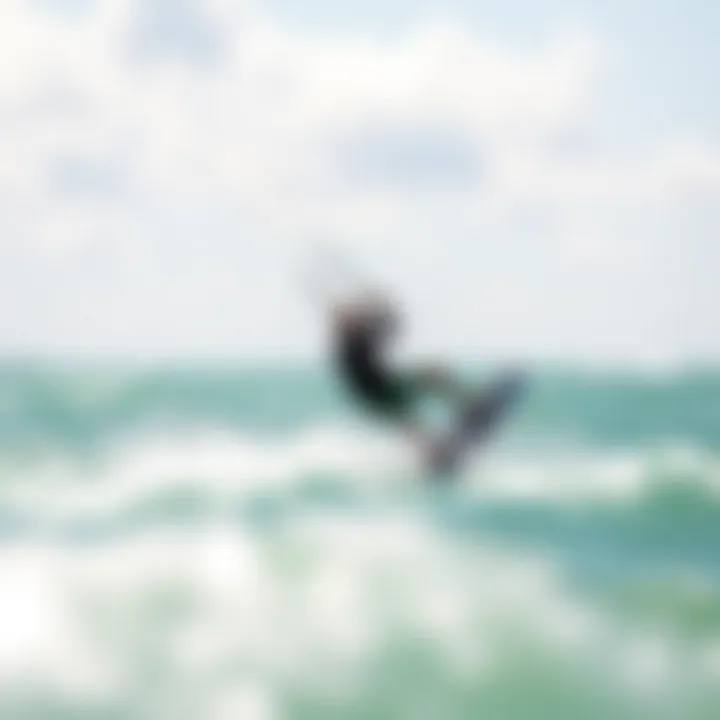
Intro
Lake Worth, located in sunny Florida, serves as a prime spot for kiteboarding enthusiasts. With winds that sweep across the coastline, this location attracts both seasoned pros and newcomers eager to catch the breezes. However, understanding Lake Worth's weather patterns is crucial for making the most out of each session. From temperature fluctuations to wind conditions, every detail plays a part in ensuring that kiteboarders experience optimal performance and enjoyment.
The purpose of this article is to give kiteboarders a deeper understanding of how local weather influences their time on the water. We will explore significant factors like seasonal changes, typical wind patterns, and temperature variations that can impact kiteboarding activities. In addition, this piece aims to provide useful strategies for kiteboarders to plan their sessions effectively. Whether you’re gearing up for your first lesson or trying to perfect that advanced maneuver, knowing what to expect from the weather can make all the difference.
Understanding Lake Worth Weather
Understanding the weather patterns in Lake Worth is not just an academic exercise; it’s essential for kiteboarders, instructors, and anyone keen on the sport. This locale, nestled along the southeastern coast of Florida, serves up a variety of atmospheric conditions that can either make or break a kiteboarding session. From wind speeds to precipitation trends, grasping these elements enables kiteboarders to optimize their experiences on the water.
Knowing the typical weather conditions can help kiteboarders plan ahead and adapt their strategies accordingly. For instance, understanding when the winds will be at their prime allows riders to perfect their timing, enhancing the thrill of catching waves. Moreover, this local knowledge can serve to avoid those sudden storms or squalls that can leave one stranded and soaked, jeopardizing not just the day but safety as well.
Geographical Overview
Lake Worth is blessed with a coastal geography that creates unique weather interactions. The area borders the Atlantic Ocean, which plays a pivotal role in regulating temperatures and wind patterns. Coastal breezes, influenced by ocean currents and land topography, add to this intricate dance of nature.
The presence of Lake Worth Lagoon further enriches the local climate, providing a variety of microenvironments. These variations can lead to different wind conditions compared to just a few miles inland, an aspect that kiteboarders should leverage. By analyzing these geographical factors, kiteboarders can take full advantage of the local atmospheric phenomena, making informed decisions about where and when to hit the water.
Climatic Conditions
Lake Worth experiences a subtropical climate, characterized by warm winters and hot summers. The seasonal shifts aren’t overly dramatic but have distinct patterns that kiteboarders must recognize.
- Winter: Typically mild, with average temperatures hovering around the 70s Fahrenheit. Wind patterns begin to stabilize, making it a popular time for kiteboarding.
- Spring: The transition season, with temperatures climbing into the 80s and winds becoming more dynamic. This is when kiteboarding begins to pick up momentum.
- Summer: The heat cranks up, making the area steamy. Afternoon thunderstorms are common, often impacting the regular kiteboarding schedule. Wind conditions may vary more dramatically during this time.
- Autumn: A gradual cooling off takes place, waters remain warm but winds can start to stabilize again, setting the stage for excellent kiteboarding conditions.
Understanding these climatic rhythms provides kiteboarders with the insights necessary for navigating Lake Worth's weather successfully. Adapting to these patterns can lead to more satisfying and safe experiences out on the water. With the right knowledge and preparation, kiteboarding in Lake Worth becomes not just a pastime, but a well-tuned art.
Temperature Trends Through the Year
Understanding temperature trends throughout the year is pivotal for kiteboarders in Lake Worth. Kiteboarding, as an exhilarating yet demanding sport, is heavily influenced by temperature variations. Knowing these trends helps athletes optimize their sessions, ensuring they catch those ideal winds, while also keeping an eye on comfort and safety.
Winter Temperatures
During winter, typically from December to February, Lake Worth experiences a reprieve from the sweltering summer heat. Temperatures can descend to about 50°F (10°C) at night, but they usually hover around a pleasant 70°F (21°C) during the day. This moderate climate makes winter a charming season for kiteboarding enthusiasts—not too hot for endurance and not too cold for enjoyment. Don't forget a light jacket, though, as coastal winds can add a noticeable chill in the evenings.
- Advantages of Winter Sessions:
- The winds during winter tend to be steadier and more predictable.
- A decrease in crowds allows kiteboarders to savor the open water.
- Ideal temperatures make it comfortable for extended sessions.
Spring Dynamics
As spring rolls in, from March to May, temperatures begin to creep upwards, averaging around 75°F (24°C) to 85°F (29°C). This transition is marked by fluctuating winds, which can be exhilarating but also unpredictable. Spring is notable for its capricious nature—one moment the sun shines bright, and the next, it’s raining cats and dogs. Kiteboarders need to be versatile, adapting their strategies to shifting conditions.
- Key Considerations:
- Layering becomes essential. Mornings can be cool, while afternoons may heat up fast.
- Kiteboarders should prepare for sudden weather changes. A reliable weather app can make a world of difference.
- This season often sees the onset of warmer winds conducive for beginner kiteboarders, making it an optimal time for lessons and practice.
Summer Heat
Summer, extending from June to August, throws down the gauntlet with temperatures climbing as high as 90°F (32°C) and beyond. The real kicker is the humidity—Lake Worth can get sticky, forcing kiteboarders to stay hydrated. While summer days can be steamy, they also bring about the best wind conditions for kiteboarding, particularly in the afternoons when sea breezes kick in.
- Tips for Handling the Heat:
- Schedule sessions early in the morning or later in the afternoon when temperatures are more bearable.
- Always bring plenty of water and consider lightweight gear to stay cool while riding.
- Keep an eye on afternoon thunderstorms, as summer storms can roll in quickly.


Autumn Cooling
As the temperatures start their descent in autumn, typically from September to November, Lake Worth sees a return to cooler and more stable conditions. Daytime highs range from 70°F (21°C) to 80°F (27°C) while nights can cold speak around 60°F (15°C), perfect for cool evening rides. This season offers consistent winds, which can be particularly appealing after the sporadic gusts of summer.
- Advantages of Autumn Riding:
- Lesser humidity makes for more pleasant riding conditions.
- The weather is less chaotic; kiteboarders can look forward to steady winds.
- It's also a great time to catch those scenic sunset sessions as the sun dips behind the horizon.
In essence, understanding temperature trends in Lake Worth is not merely an academic exercise; it can directly influence a kiteboarder’s performance and overall experience on the water. By aligning their sessions with seasonal shifts, kiteboarding enthusiasts can maximize both their safety and enjoyment.
Precipitation Patterns
Understanding precipitation patterns is vital for kiteboarders in Lake Worth, as rain can significantly impact not only the comfort levels during sessions but also the overall kiteboarding experience. Frequent rainfall can alter the landscape of the water, affecting conditions like visibility and water levels, which consequently plays a role in safety and performance. A solid grasp of rainfall patterns assists in planning kiteboarding sessions, ensuring enthusiasts can optimize their time on the water while minimizing disruptions.
Monthly Rainfall Averages
Typically, Lake Worth experiences varied rainfall through the year. The wet season, concentrated largely between June and September, tends to unleash the bulk of annual precipitation. During these months, averages can reach around 6-7 inches per month, creating a lush and tropical atmosphere but requiring careful timing for kiteboarding. Conversely, the winter months bring a significant dip in rainfall, averaging a mere 2 to 3 inches, making it an attractive period for kiteboarding due to clearer skies and settled weather.
One commonly cited observation is that the rains following sunny days can freshen the water, making the environment feel more pleasant for those who spend hours on the water. Here’s a breakdown by months:
- January: 2 inches
- February: 2.5 inches
- March: 2 inches
- April: 2.5 inches
- May: 3.5 inches
- June: 7 inches
- July: 6.5 inches
- August: 7 inches
- September: 6 inches
- October: 4 inches
- November: 3 inches
- December: 3 inches
This breakdown reflects a typical year and does shift occasionally based on broader climatic trends. Over time, shifts in these averages have been noted, related to climate change, impacting the predictability directly experienced by local kiteboarding communities.
Impact of Rain on Kiteboarding
Rain impacts kiteboarding in several ways, and understanding these influences can be the key to a memorable experience.
- Wind Changes: Rain often correlates with shifts in wind patterns, which can change how the kiteboard operates. During a storm, winds can become unpredictable, increasing risks for novice kiteboarders.
- Water Conditions: Rain can stir up the water and create challenging conditions, such as choppy waves, but it can also mean increased freshness, particularly beneficial after dry spells.
- Safety Considerations: Wet surfaces and rain can create hazards, like slippery equipment or potential lightning in severe storms. Therefore, it’s crucial to monitor weather forecasts and seek shelter when necessary.
- Visibility: Heavy rain can reduce visibility on the water, making it harder to see approaching locals or obstacles, which compound safety issues. Particularly in peak tourist seasons, awareness is essential to mitigate potential mishaps.
In short, kiteboarders should not only look at the sunniest forecasts but also pay attention to rainfall predictions as part of their planning. Forecast tools, like Weather.com or local meteorological services, can provide updates on imminent rain events.
Important Note: Remember always to check local forecasts on NOAA or similar services before heading out for a session.
With a firm handle on rainfall averages and their implications, kiteboarders can better strategize their time on Lake Worth’s waters, leading to an enhanced experience and improved safety.
Wind Conditions and Their Importance
Wind is the lifeblood of kiteboarding. It drives not just the sport but shapes the very environment kiteboarders find themselves in. Understanding wind conditions in Lake Worth is crucial for enthusiasts who seek to exploit the optimal conditions for their sessions. Not only does the wind determine the feasibility of kiteboarding on any given day, but it also affects performance, safety, and overall enjoyment. As they say, "a rising tide lifts all boats," and in kiteboarding, a good wind does the same for kiteboarders.
Typical Wind Patterns
Lake Worth enjoys a reputation as a kiteboarding hotspot, largely due to its consistent wind patterns. The prevailing winds typically come from the east-southeast, particularly during the warmer months. For instance, from late spring through early autumn, kiteboarders often see sustained winds ranging from 15 to 25 knots, making for exhilarating sessions.
- Morning Winds: Often, the mornings start off calm, but by around mid-morning, the winds begin to pick up. Kiteboarders looking for laid-back, leisure sessions might benefit from these lighter morning breezes.
- Afternoon Gusts: As the sun climbs higher, the afternoon brings stronger winds, which are preferred by more experienced kiteboarders. Conditions can be lively, with gusts providing the thrill many seek.
- Evening Calm: Interestingly, as the sun sets, the winds tend to mellow again, offering a contrasting experience for those who enjoy twilight sessions.
Each of these patterns is not just significant in terms of performance but also in planning. A kiteboarder needs to know when to hit the water and when to wait, depending on these wind patterns.
Wind Speed Variations
Wind speed is another critical factor, and it varies notably throughout the year. Kiteboarders must acclimate to these changes to harness the elements effectively. During peak months, the wind can blow steady at 20 knots or more. Such conditions provide an exhilarating experience, but they also demand skill and safety awareness.
Understanding the general wind speed variations is key:
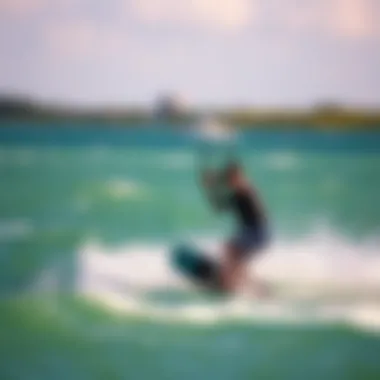
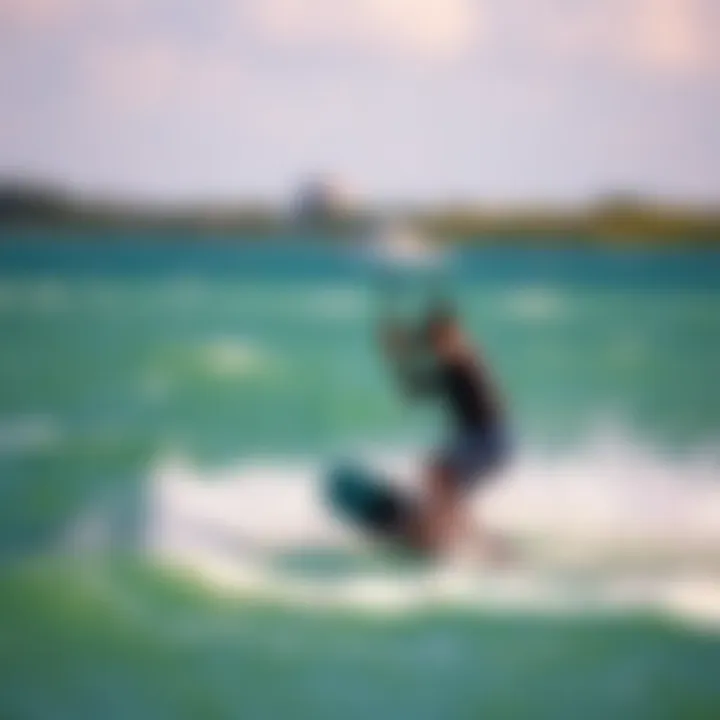
- Winter: Wind speeds can dip, averaging around 10-15 knots. Though still kiteable, these months can be more unpredictable. It's advisable for beginners to approach with caution.
- Spring: As temperatures rise, so do the winds. Spring typically brings faster and consistent winds, pushing 15-20 knots. This is often regarded as the sweet spot for many kiteboarding fans.
- Summer: The summer heats up not just with temperatures but also with wind speed. Here, kiteboarders might regularly enjoy winds in the range of 20-25 knots. However, thunderstorms can also lead to sudden speed changes, requiring vigilance.
- Autumn: As summer winds down, wind speeds can vary as weather begins to transition. Generally, summery winds persist, but they might taper off heading into winter.
"For kiteboarders, understanding wind speed variations not only impacts choice of gear but also safety measures. When venturing into uncertain or high-speed conditions, the mantra should be: better safe than sorry."
With these insights, kiteboarders can better prepare for their sessions. Whether gearing up for a calm run or bracing for a wild ride, understanding the wind conditions sets the stage for a successful outing. For more detailed forecasts and wind charts, check out resources like National Oceanic and Atmospheric Administration or local kiteboarding forums on Reddit.
Ultimately, the wind can make or break a kiteboarding day, and those savvy enough to adapt to its ebbs and flows stand to benefit immensely.
Seasonal Weather Insights for Kiteboarders
Understanding seasonal weather patterns is crucial for kiteboarders, particularly in a venue like Lake Worth, where conditions can fluctuate rapidly. Each season presents its own unique set of circumstances that can greatly impact kiteboarding experiences. This means being savvy about the nuances of wind patterns, temperature changes, and potential weather events or hazards throughout the year.
Knowing these seasonal insights not only aids in choosing the best times for kiteboarding but also helps with preparation for any seasonal challenges. Both novice and seasoned kiteboarders can strategize their sessions more effectively and make informed decisions about when to head to the water. With the right information, kiteboarders can ensure they harness optimal conditions, maximizing pleasure and safety during their time on the water.
Best Times for Kiteboarding
Lake Worth tends to shine particularly bright for kiteboarding between November and April. During these months, the weather brings more consistent winds, averaging between 15 and 25 miles per hour, which is ideal for kiteboarding.
Additionally, the temperatures hover around a comfortable range, usually between 70 and 80 degrees Fahrenheit, making for pleasant sessions without the oppressive heat that summer can bring. For kiteboarders, the cooler months not only offer more reliable winds but also ensure fewer storms and unpredictable weather events that can ruin a good day's ride.
However, should you venture to the spot during the peak of summer, consider early morning or late afternoon sessions when the thermals start kicking in. It can get quite steamy in the heart of summer, often reaching into the 90s, making it more taxing on the body. Plan ahead, layering your gear as necessary, and don't forget the sunscreen!
Seasonal Challenges
Despite the allure of kiteboarding in Lake Worth, each season comes with its own bag of tricky challenges.
- Winter: Though wind is more consistent, cold fronts can sweep through, bringing chillier temperatures that might catch you off guard if you're not properly prepared.
- Spring: The transition into spring can yield unpredictable squalls and storms, so monitoring weather forecasts becomes essential.
- Summer: This time can be a double-edged sword; while the wind may be less reliable, afternoon thunderstorms can roll in quickly, leading to dangerous conditions if you're on the water.
- Autumn: Just as summer winds down, the change in atmospheric patterns can lead to sudden drops in temperature and gusty winds.
Kiteboarders should always listen to weather alarms and local forecasts; it’s better to be safe than sorry! A well-informed rider will have a better grip on when to ride and when to pack up for another day.
Long-term Climate Change Effects
Understanding the long-term climate change effects at Lake Worth is crucial for anyone involved in kiteboarding. With the environment constantly shifting, the implications on weather patterns and, consequently, kiteboarding conditions can be profound. Kiteboarders must stay informed about these changes to make best use of their time on the water and ensure their safety.
Historical Changes in Weather Patterns
In recent decades, Lake Worth has seen notable shifts in its weather. For example, data shows an increase in average temperatures during summer months, leading to more intense heat waves. These warmer conditions not only affect when one can comfortably kiteboard but also have repercussions on water conditions. Higher temperatures can lead to a decrease in water levels, affecting the general landscape and potentially limiting accessible kiteboarding zones.
Moreover, precipitation patterns have fluctuated, causing heavier rainfall during certain times of the year while leaving other periods strangely dry. This erraticness can throw a wrench in the planning, as flooding events may create unsafe conditions, while a lack of rain can result in dust storms. The community needs to be aware of these historical changes in weather patterns for better preparation.
"Weather doesn't wait for anyone; it’s wiser to adapt than to be caught in a storm."
Future Projections
Future projections concerning the weather in Lake Worth indicate that these trends may continue to intensify. Some forecasts predict that average yearly temperatures could rise by up to 2 degrees Fahrenheit by 2050. For kiteboarders, this marks a shift in scheduling; summer sessions might start earlier in the year, extending hot weather. However, with these shifts, there’s also the likelihood of erratic wind patterns, which can disrupt ideal kiteboarding conditions.
On top of that, the interaction between increased temperatures and humidity can lead to more frequent storms. Predicting whether a sunny day will turn into a rainy mess could become trickier. Hence, kiteboarders are encouraged to maintain awareness of these forecasts and plan their sessions accordingly. Keeping abreast with local weather talks, perhaps via meteorological services or community forums, will be essential. Knowing how climate change might shape the kiteboarding landscape is not just a convenience, it's a necessity for success and safety on the water.
In sum, while long-term climate change poses potential challenges, staying informed can help the kiteboarding community navigate these changes effectively.
Weather Forecasting: Tools and Resources
Understanding the weather is paramount for kiteboarders looking to catch the best winds and enjoy their sessions to the fullest. Weather forecasting tools and resources play an essential role in this pursuit. Reliable forecasts can mean the difference between a thrilling day on the water and a disappointing one spent waiting for ideal conditions that never show up. With the right info at hand, kiteboarders can make informed decisions about when and where to hit the waves.
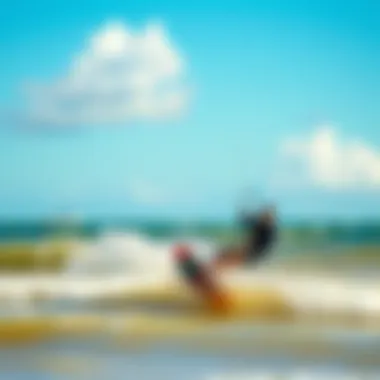
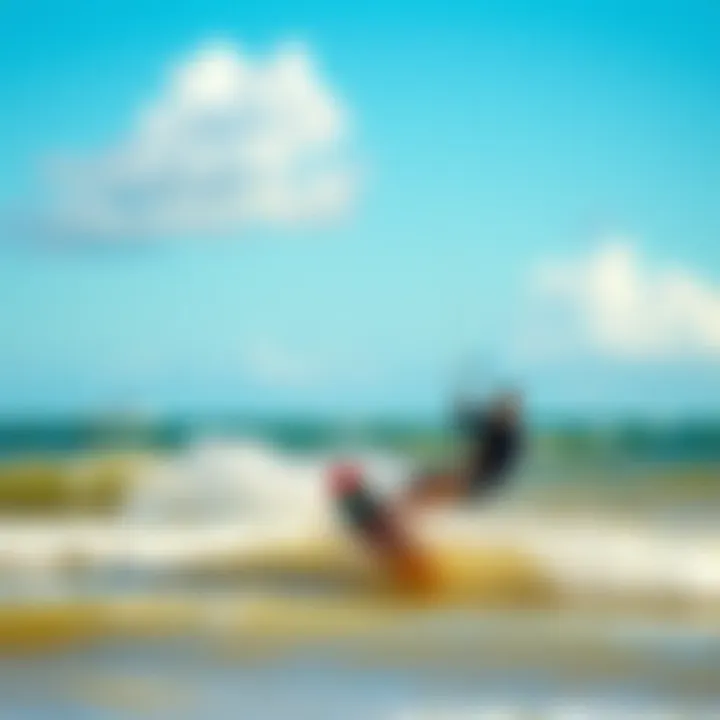
Utilizing Weather Apps
In today's digital age, mobile weather applications have revolutionized the way kiteboarders access real-time data. These apps provide instant updates on wind speeds, temperature, and precipitation—key elements that can dramatically influence one’s kiteboarding experience. Popular choices like Windy and Kitefinder allow users to zoom in on specific locations and visualize wind patterns, which is incredibly helpful.
- Features: Many of these apps come equipped with features like:
- User-Friendly Interface: They often have simple interfaces that present data in a straightforward manner, making it easy for both beginners and experienced kiteboarders to grasp.
- Community Integration: Some platforms even allow users to share their experiences and conditions with others, creating a communal atmosphere where tips can be shared.
- Live wind maps
- Hourly forecasts
- Alerts for sudden weather changes
By relying on these applications, kiteboarders can avoid going out in unsuitable conditions. A quick glance at the app can save one from battling little to no wind or dealing with the dread of incoming storms.
Local Meteorological Services
While mobile apps can be handy, they sometimes lack the granularity that local meteorological services provide. Organizations like the National Weather Service and local weather stations offer essential resources tailored to specific regions. For Lake Worth, these services have a wealth of data, including:
- Detailed Forecasts: These forecasts often include far more nuanced information compared to generic weather apps. They might offer insights specific to kiteboarding, such as the probability of gusty winds or changes in temperature.
- Special Reports: During events, such as tropical storms or hurricanes, local agencies issue advisories that are crucial for the safety of water sports enthusiasts.
- Access to Academic Research: Local universities may provide in-depth climatological studies and predictions about seasonal weather changes, which can be particularly useful when planning longer-term kiteboarding sessions.
It is worth noting that one should not only rely on one source for weather information. By cross-referencing data from both apps and local meteorological services, kiteboarders can get a much clearer picture of what to expect on the water.
"Weather is a tricky business; it pays to stay ahead of the game with the right resources and tools. Knowledge is your best friend out there on the waves."
In summary, effective weather forecasting utilizing both modern apps and traditional meteorological services empowers kiteboarders. Attention to weather details can optimize performance, enhance safety, and ultimately elevate the overall kiteboarding experience in Lake Worth.
Impact of Local Weather on Kiteboarding Communities
The intricate dance between local weather conditions and kiteboarding is pivotal for enthusiasts. It dictates not only when they can hit the waves but also the safety and enjoyment levels during each session. For the kiteboarding community in Lake Worth, the local weather plays an integral role in shaping their experiences. Understanding these weather patterns helps individuals gauge their riding days, optimizing their sessions for the best conditions.
Kiteboarding comes with its set of risks, and favorable weather minimizes those hazards significantly. When local conditions are stable, it encourages participation among new and seasoned kiteboarders alike. The community thrives on the knowledge shared among its members about local winds and temperatures. Such insight creates a vibrant atmosphere where everyone feels more secure while navigating development trends like equipment and technique.
Community Responses to Weather Trends
Kiteboarding communities often showcase resilience and adaptability in response to changing weather patterns. For instance, when unexpected storms approach, local riders quickly share alerts via social media, ensuring that others are aware and can adjust their plans accordingly. There’s a sense of camaraderie here, as kiteboarders communicate over platforms like Facebook and dedicated groups on Reddit, discussing recent trends and forecasts.
Moreover, local organizations frequently host community meetings to discuss weather patterns and their implications on the sport. This proactive approach fosters preparedness, equipping members with strategies to cope with adverse conditions. The continuous learning about weather phenomena allows every kiteboarder to adapt their riding techniques as environmental factors shift.
"Engaging with the community enriches our love for kiteboarding, making every session not just a ride, but an experience."
Event Planning and Weather
Event planning for kiteboarding competitions hinges heavily on predicting weather conditions. Local clubs collaborate with meteorologists to ensure that events are scheduled during optimal times. Wind speed, direction, and temperature all affect these decisions. In Lake Worth, there’s a trend toward organizing competitions during specific seasons when forecasted wind patterns are most favorable.
When planning an event, several factors come into play:
- Wind Consistency: Ideal wind conditions tend to foster exciting competitions.
- Temperature Comfort: Extreme temperatures can deter participation.
- Local Precipitation Patterns: A last-minute rain shower can lead to cancelation, so keeping an eye on forecasts is vital.
- Community Engagement: The success of any event often relies on local enthusiasm; thus, choosing dates that maximize participation is key.
To minimize disruption, organizers frequently employ weather tracking tools and resources such as NOAA and specialized forecasting websites. Aligning community activities with favorable weather inherently boosts attendance, fostering a sense of unity among kiteboarders. Each event thus becomes an opportunity to connect with nature while enjoying the camaraderie that comes from a shared passion for the sport.
Understanding this weather dynamic undoubtedly enriches the kiteboarding community in Lake Worth, ensuring that kiteboarders can make the most out of what nature presents.
Ending
The conclusion of this article underscores the critical role that understanding Lake Worth's weather plays in enhancing kiteboarding experiences. Kiteboarding isn't just about having a board and a kite; it’s about making informed decisions based on current and anticipated weather conditions.
One vital takeaway from this analysis is recognizing how temperature, wind, and precipitation patterns can directly impact kiteboarding sessions. With clarity on these elements, kiteboarders can better plan their outings, minimizing risks while maximizing their thrill on the water.
Summary of Key Points
- Weather Patterns: As noted, Lake Worth exhibits unique weather characteristics that can influence kiteboarding experiences. Being aware of these can lead to safer and more enjoyable sessions.
- Seasonal Impacts: Understanding seasonal temperature variations and their effects on wind can help kiteboarders pinpoint the best times to ride. The shifting climatic conditions reflect a tapestry of opportunities and challenges.
- Community Insights: The collaboration within the kiteboarding community plays a crucial role in responding to weather trends. Sharing experiences and recommendations can create a more cohesive approach to tackling any adverse conditions that may arise.
- Preparation is Key: Engaging with weather forecasting tools and local services equips kiteboarders to stay one step ahead. Having knowledge about immediate weather forecasts can be the difference between a fantastic ride and a disappointing one.
Recommendations for Kiteboarders
- Stay Updated: Regularly check local forecasts and weather apps for the most accurate information. Weather changes can happen fast, so continual vigilance is essential. Apps like Windy and Weather Underground provide real-time data specific to kiteboarding.
- Join Local Groups: Collaborating with local kiteboarding communities can enhance your readiness. Resources such as forums on Reddit (reddit.com/r/kiteboarding) or Facebook can offer valuable insights from fellow kiteboarders who have experienced local conditions.
- Prioritize Safety: Always consider weather conditions when planning your sessions. High winds can be exhilarating but also dangerous. If you notice an uptick in winds or incoming storms, it may be wise to pack it in.
- Plan Around Events: Look into local kiteboarding events or community meet-ups that coincide with favorable weather. Engaging with others in the sport can lead to enriching experiences on the water.
- Document Your Ride: Keep track of how different weather conditions affect your sessions. By noting these details, over time, you can develop a detailed perspective on the best conditions for your personal preferences.







